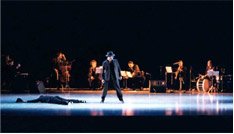+ madama butterfly + l'italiana in algeri + la clemenza di tito + orestes + lucia di lammermoor
sinópsis
Los personajes de esta obra están situados en un período de transición de la historia argentina y en un arrabal porteño. La acción se desarrolla en el ámbito de los viejos reñideros. En este círculo cerrado se rinde culto al coraje, descuella el hombre que se impone tanto en la pelea como en el baile. Es el mundo pintoresco de los guapos y el malevaje, donde domina el más fuerte y el más diestro con el cuchillo. Las relaciones se establecen mediante rígidos códigos de honor que incluyen la intolerancia y la violencia.
Pancho Morales encarna el mito del guapo. Su muerte desencadena una sucesión de encontradas visiones sobre su persona y el mundo que él representa.
Elena, su hija, quiere vengarlo y a través de nostálgicos raccontos ensalza la figura y el mundo paterno. Su amor incondicional a los valores y a la época de Morales conforma su destino infausto. El mundo evocado por Nélida, su mujer, se opone al clima de cólera y sangre representados por el reñidero. Su recuerdo está teñido de los costados negativos de ese mismo ambiente. Orestes, hijo de Morales, está atado a los códigos paternos pero sin convicción personal. Lucha por vencer la descalificación paterna y se somete para obtener su cariño y respeto.
Y es a través de Orestes que la acción se desplaza hacia el verdadero nudo dramático: el cambio de perspectiva social y la desmitificación del guapo.
La muerte de Morales reanima el enfrentamiento que Elena sostiene con su madre. Acusa a Nélida y a Soriano, su amante, como los responsables de su muerte. Orestes llega al velatorio luego de cumplir una condena por un crimen en defensa de los intereses paternos. Elena obsesionada presiona a Orestes para que vengue a su padre.
Orestes se convierte así en la víctima de estos mundos enfrentados. El amor que lo une a su madre y la amistad fraterna con Vicente, darán lugar a otros raccontos sobre la mezquindad y traición de su padre. Las fuerzas oponentes se juegan ahora dentro de él. Deberá decidir entre escuchar a Elena y cumplir la venganza según los códigos de ese mundo o seguir su propio camino. Pero la constante necesidad de reconocimiento paterno lo llevará a transitar su inevitable destino.

Sexteto de tango
Morales, man of honour and strength of Palermo1
Orestes, his son
Elena, his daughter
Nélida, his wife
Soriano, man who has the confidence of Morales and lover of Nélida
Vicente, friend of Orestes
La Mujer de la Milonga, alter ego of Morales
Neighbours and milongueros2
The characters of Orestes are situated in the Porteño neighborhoods during a period of transition in Argentine history. It is the picturesque world of guapos3 and malevaje,4 where the strongest men, slick with knives and with women, dominate. Worshipped is the man of courage who rises above the rest in battle as well as in dance. In this setting of guapos, relationships are established through rigid codes of honour that do not exclude intolerance and violence. Because refusing any incitement would mean dishonour, its characters are forced to be in constant readiness for duel.
Synopsis
The death of Pancho Morales sets off this story of a guapo recounted through the memories of his daughter, Elena. Elena not only takes upon herself the death of her father but his entire person. This unconditional adhesion to the values of Pancho’s age determine her unfortunate destiny. Through Elena’s narration Morales embodies the myth of the guapo, touching upon the nostalgia and positive aspects of malevaje. It is the darker sides of this setting that are depicted simultaneously through the memories of Pancho’s wife, Nélida.
In tacit condemnation of provocation and self-executed justice, Nélida and Vicente search for convivial peace; opposing the codes of the cock fighting pit’s circle of rage and blood. The drama unleashes when both worlds collide. It is through Orestes, the son, that the plot turns toward the true dramatic twist: the change of the socio-political scene and the demystification of the guapo. Orestes, son of Pancho Morales, finds himself tied to his father’s codes of conduct without much personal conviction. In them, he looks for an affirmation of his own persona. In pathetic submission he attempts to win over his father’s indifference and procure his love and respect. Driven by the need for his father’s affection and admiration, Orestes commits murder. Elena’s unquenchable thirst for revenge is awakened when Orestes reappears at his father’s funeral. She accuses Nélida and Soriano, her own lover, of the murder. Obsessed with avenging her father’s death, she then pushes Orestes to eliminate Nélida and Soriano. Orestes is the victim of the collision of two contradicting worlds. The strong affectionate link that ties him to his mother and Vicente’s fraternal friendship make place for revealing episodes that further demystify the figure of Pancho Morales.
Orestes must decide between carrying forth the revenge according to the codes of honour and bravery of his paternal world and listening to his own desires: those of the man who does not wish to kill.
1. Of the port city of Buenos Aires
2. Those who dance tango and milonga
3. Gallant bullies of the porteño subculture
4. The mischievous subculture of the porteño lower class neighbourhoods; a macho world where passion, blood and tango intertwine